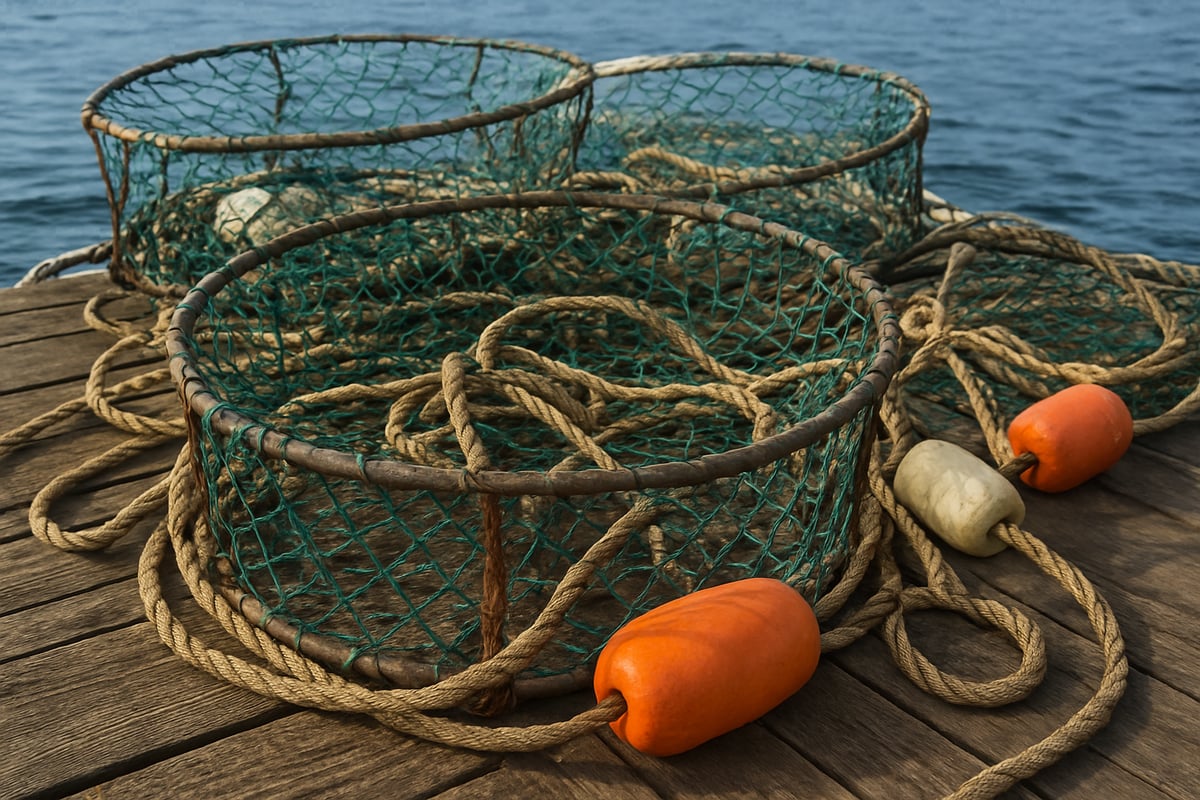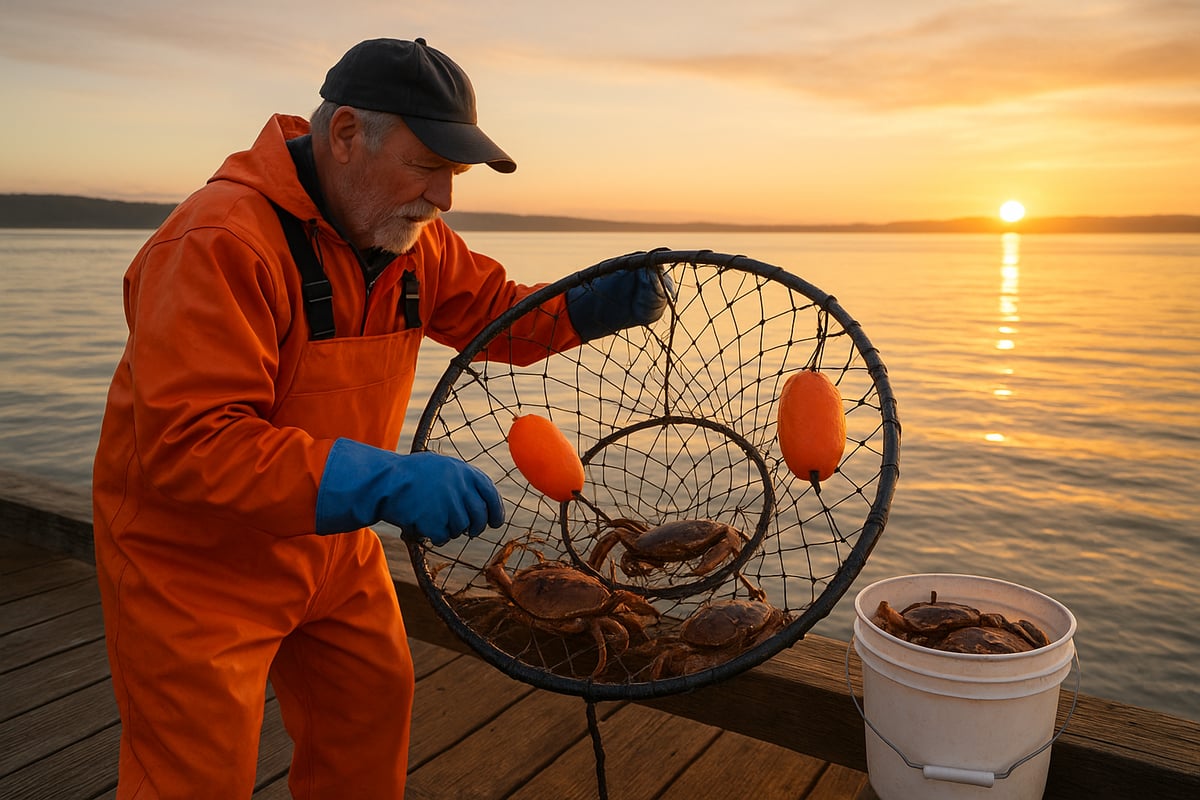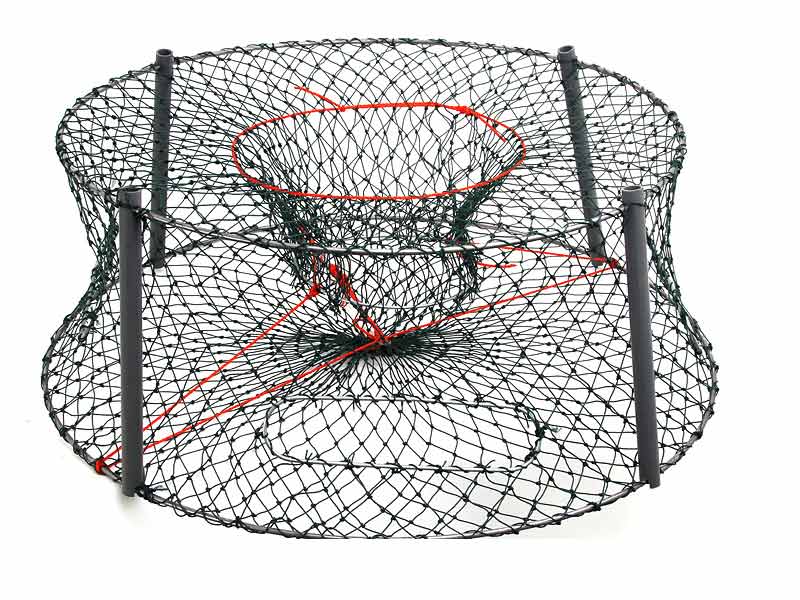Are you ready to make 2025 your most successful crabbing season yet? The crab hoop net has become the go-to choice for both casual enthusiasts and seasoned professionals, thanks to its simplicity and impressive results.
Interest in crab hoop net techniques is soaring as more people discover how easy and effective they are for landing a bigger catch. This guide is designed to equip you with expert tips, practical steps, and the latest advice to elevate your crabbing experience.
Here, you will learn how to select the right hoop net, gather essential gear, choose the best locations, bait effectively, and stay compliant with regulations. We will also share advanced strategies to help you maximize your haul.
Start your journey toward a more productive and enjoyable crabbing adventure by following our proven recommendations.
Understanding Crab Hoop Nets: Types, Features, and Benefits
Crabbing has become increasingly popular, and using the right crab hoop net can make all the difference for both beginners and seasoned enthusiasts. Understanding how these nets work and what sets them apart is the foundation for a successful crabbing experience. Let’s explore what makes the crab hoop net unique, the various types available, essential features, and the key benefits for your next outing.

What is a Crab Hoop Net?
A crab hoop net is a simple yet effective device designed for catching crabs in shallow coastal waters. Unlike bulky box traps or complex ring nets, the crab hoop net uses one or two circular rings connected by durable mesh and attached to a rope for easy retrieval. This design allows for quick deployment and minimal disturbance to the surrounding environment.
The typical construction of a crab hoop net includes corrosion-resistant rings, sturdy nylon or polyethylene mesh, and a long retrieval line. This setup is lightweight and portable, making it ideal for use from piers, jetties, or small boats. Compared to other crabbing gear, the crab hoop net stands out for its ease of use and reliability. For readers interested in exploring more about various fishing nets and their applications, the Fishing Nets Overview and Types page provides valuable insights.
Main Types of Crab Hoop Nets
There are two primary types of crab hoop net: single-ring and double-ring designs. The single-ring style features one large ring with a mesh bag or pocket hanging below, while the double-ring version uses two rings—one at the top and one at the bottom—to create a more stable, cylindrical trap. Double-ring models generally offer higher catch rates and are easier to manage in moving water.
Popular 2025 models like the Promar Ambush XL and Tsunami Double Ring are available in different sizes and materials, including coated steel and aluminum for long-term durability. Mesh options may range from heavy-duty nylon for saltwater use to lightweight polyester for freshwater environments. Choosing the right crab hoop net type depends on your target species, preferred fishing location, and personal preference.
Key Features to Look For
When selecting a crab hoop net, prioritize mesh size, material strength, and overall durability. Nets with smaller mesh help retain even smaller crabs while preventing escape, whereas heavy-duty materials resist tearing and corrosion. Collapsible or foldable designs are a bonus for anglers who need to transport their gear easily.
Additional features to consider include rope length for accessing deeper waters, brightly colored floats for visibility, and reinforced attachment points to handle larger catches. Corrosion resistance is crucial for saltwater crabbing, so look for nets with coated rings and marine-grade materials. Investing in a well-made crab hoop net ensures reliable performance trip after trip.
Benefits of Using Hoop Nets for Crabbing
Opting for a crab hoop net offers several practical advantages. Setup and retrieval are quick, allowing for efficient crabbing with minimal downtime. These nets are less likely to trap non-target species, which helps reduce bycatch and environmental impact. Their versatility means you can use them from shore, piers, or boats, adapting easily to different locations.
Affordability is another key benefit, as crab hoop nets are generally less expensive than other types of crabbing equipment. For both recreational and professional crabbers, this makes them an accessible choice without sacrificing effectiveness. With the right crab hoop net, you can enjoy a productive and sustainable crabbing experience.
Choosing the Right Crab Hoop Net and Essential Gear
Selecting the right crab hoop net and having the best gear is the foundation of a productive crabbing trip. With so many options on the market in 2025, understanding what to look for can make the difference between a modest catch and a day to remember. Let’s break down the essentials, from choosing your net to maintaining it for years of reliable use.

How to Select the Best Hoop Net for Your Needs
When choosing a crab hoop net, start by identifying your target species. Blue crab, Dungeness, and mud crab each require different mesh sizes and net designs. Always check local regulations for allowed net sizes and mesh dimensions to stay compliant.
Prioritize build quality, as a well-made crab hoop net will last longer and perform better. Look for sturdy frames, secure mesh, and reliable attachment points. Trusted brands are often worth the investment, thanks to proven durability and consistent results.
Consider portability and storage as well. Collapsible models are easy to transport and save space, especially if you plan frequent trips or have limited room on your boat or vehicle.
Must-Have Crabbing Accessories
A successful day with your crab hoop net depends on having the right accessories. Essential gear includes gloves for protection, sturdy buckets for holding your catch, and bait cages to secure your chosen bait. Measuring gauges are crucial for ensuring all crabs meet legal size requirements.
Rope and float selection is also vital for visibility and safety. Brightly colored floats help you spot your nets easily, while strong ropes prevent loss in strong currents. You can find a wide range of specialized crabbing accessories, including floats and bait cages, at Fishing Net Accessories NZ.
Protective clothing and waterproof boots will keep you comfortable and safe, whether you’re crabbing from shore or a boat. Being well-equipped enhances both safety and efficiency.
Product Recommendations and Reviews
When evaluating crab hoop net options for 2025, user reviews and expert testing provide valuable insights. For example, the Promar Ambush XL 36" Hoop Net is praised for its large capacity, durable steel rings, and corrosion-resistant mesh. However, it may be heavier than some aluminum alternatives, making transport less convenient for some users.
Other top-rated models like the Tsunami Double Ring Hoop Net offer excellent catch rates and easy handling. When comparing nets, consider size, material, and value for money. Prices typically range from budget-friendly entry-level nets to premium, feature-rich designs.
Refer to tables and reviews online for side-by-side comparisons, focusing on the features that matter most for your crabbing style.
Maintenance and Care Tips
Proper care is key to extending the lifespan of your crab hoop net. After each trip, rinse your net thoroughly with fresh water to remove salt and debris. Allow it to dry completely before storage to prevent mold and corrosion.
Inspect your crab hoop net before every outing. Check for signs of wear, such as frayed ropes or damaged mesh. Address minor repairs promptly to avoid costly replacements.
Store your net in a cool, dry place, using storage bags or bins to prevent tangling. Regular maintenance ensures your crab hoop net remains reliable and ready for the next adventure.
Step-by-Step Guide: Successful Crabbing with Hoop Nets
Crabbing success in 2025 starts with careful preparation and a strategic approach. Whether you are new to using a crab hoop net or looking to refine your technique, following a structured process ensures better results and a more enjoyable experience.

Preparing for Your Crabbing Trip
A successful outing begins well before you reach the shoreline. Always check local crabbing regulations, seasons, and any area-specific closures. This step helps avoid fines and ensures you use your crab hoop net legally.
Next, research tide charts and weather forecasts. Crabs are most active during incoming and outgoing tides, so plan your trip around these windows. Pack your gear the night before to avoid forgetting essentials. Your checklist should include your crab hoop net, bait, gloves, buckets, rope, floats, and a measuring gauge.
Safety should be a top priority. Bring a life jacket, first aid kit, and sun protection. With proper preparation, you set the stage for a productive crabbing adventure using your crab hoop net.
Setting Up Your Crab Hoop Net
Once at your chosen location, assemble your crab hoop net according to the manufacturer’s instructions. Attach the main rope securely to the net, and ensure your float is highly visible for easy retrieval.
Place bait—such as fish heads, chicken, or commercial attractants—inside a bait cage or mesh pocket at the center of the net. This placement draws crabs in and keeps them engaged. Double-check that knots are tight and the net is free of damage.
Choose a deployment spot with the right depth and substrate. Sandy or muddy bottoms near piers, jetties, or estuary mouths are ideal for attracting crabs to your crab hoop net.
Deploying the Net: Best Practices
Lower your crab hoop net gently into the water to avoid startling nearby crabs. Pay out the rope slowly, ensuring there are no tangles or snags. The float should rest on the surface for clear identification.
Proper rope management is crucial. Coil excess rope neatly to prevent it from drifting or catching on obstacles. Mark your position if deploying multiple nets. For more strategies on deployment and troubleshooting, check out the Frequently Asked Questions and Tips.
Monitor your crab hoop net placement and avoid areas with strong currents or heavy boat traffic. These best practices maximize your chances for a successful catch.
Monitoring and Retrieving the Net
After deploying your crab hoop net, allow it to soak for 15 to 30 minutes. Soak times can vary by crab species and location. Watch for float movement or subtle tugs, which may signal crab activity below.
Retrieve your net by pulling the rope steadily and smoothly. Rapid jerks can cause crabs to escape, so maintain even pressure. Once the net breaks the surface, lift it quickly but safely onto the dock or boat.
Inspect the catch immediately. This approach prevents crabs from escaping and lets you reset your crab hoop net promptly for the next round.
Handling and Measuring Your Catch
Carefully remove crabs from the net using gloves to avoid pinches. Place crabs into a sturdy bucket with a small amount of seawater. Use a crab gauge to measure each crab across the shell’s widest point.
Only keep crabs that meet the legal size limit. Return any undersized individuals to the water promptly. Handle crabs gently to reduce stress and prevent injury to both yourself and the animal.
Accurate measurement and careful handling support sustainable crabbing and ensure compliance with local laws.
Releasing Bycatch and Undersized Crabs
Not every crab in your net will be a keeper. Learn to identify non-target species and undersized crabs quickly. Use both hands to gently release these crabs back into the water, ideally at the edge of the dock or boat to minimize injury.
If you catch egg-bearing females, always release them. This simple action helps maintain healthy crab populations for the future. Practicing responsible release techniques is essential for ethical and sustainable crabbing.
By following this step-by-step process, you will become more confident and efficient with your crab hoop net, making every trip more rewarding.
Expert Tips to Maximize Your Crabbing Success in 2025
Mastering the art of crabbing with a crab hoop net requires more than just the right equipment. Expert strategies, careful timing, and a focus on safety can elevate your results. Below, you will find actionable tips designed to maximize your catch in 2025 while ensuring a rewarding and responsible experience.

Selecting the Best Locations and Times
Choosing the right location can make all the difference for your crab hoop net results. Productive spots often include piers, estuaries, and rocky shorelines where crabs naturally congregate.
Crab activity peaks during incoming and high tides, so plan your trips around these times for the best chances. Seasonal patterns also play a crucial role, as some species become more active during warmer months or after rainfall.
Leverage local knowledge by talking to experienced crabbers and checking online forums. Reliable resources, such as California Department of Fish and Wildlife: Recreational Ocean Fishing Regulations, provide up-to-date location and timing guidelines. This ensures your crab hoop net efforts are both successful and compliant.
Baiting Strategies for Bigger Catches
Selecting the right bait is essential for attracting more crabs to your crab hoop net. In 2025, top choices include fish heads, raw chicken, squid, and specially formulated commercial attractants. Each option offers a distinct scent profile that appeals to various crab species.
Consider using a bait cage for longevity or a mesh pouch for maximum scent dispersion. Rotate your bait every couple of hours to keep the aroma fresh and inviting. The fresher your bait, the more likely it will entice hungry crabs.
Experiment with bait placement within the crab hoop net to optimize accessibility. Sometimes, elevating bait slightly above the mesh can prevent small fish from stealing it, leaving more for your target catch.
Advanced Techniques for Experienced Crabbers
For those seeking to boost their harvest, deploying multiple crab hoop net setups can greatly increase your yield. Stagger your nets along different depths and substrates to pinpoint where crabs are most active on a given day.
Try combining your crab hoop net with hand lines or dip nets to catch stragglers. This multi-method approach keeps you engaged and enhances your overall results.
Keep detailed notes after each outing, tracking which advanced methods deliver the best results under specific conditions. Over time, you will refine a personal system that consistently outperforms basic crabbing techniques.
Troubleshooting Common Issues
Even seasoned crabbers encounter challenges with their crab hoop net setups. Lost nets, tangled ropes, and bait theft are frequent frustrations. To minimize lost gear, always use brightly colored floats and regularly check your lines for wear.
When dealing with strong currents or snags, avoid abrupt pulls and instead use slow, steady pressure to free the net. If fish or wildlife repeatedly steal your bait, switch to a more secure bait cage or try using tougher, less palatable bait for non-crab species.
Stay organized by keeping a repair kit on hand, including extra rope and zip ties. This proactive approach ensures that minor setbacks do not cut your crabbing adventure short.
Safety and Comfort Tips for Crabbing Trips
Safety is as essential as skill when using a crab hoop net. Always wear non-slip footwear, especially on wet docks, and bring gloves to protect your hands from sharp shells.
Pack a small first aid kit for minor injuries, such as crab pinches or scrapes. Hydration, sun protection, and snacks will help keep your energy up during longer outings.
Never crab alone in remote locations, and always let someone know your plans. By following these comfort and safety tips, you can focus on perfecting your crab hoop net technique and enjoying the experience.
Crabbing Laws, Regulations, and Conservation in 2025
Understanding the rules around crabbing is essential for a successful and responsible experience. Whether you are new to using a crab hoop net or an experienced crabber, following regulations protects crab populations for future generations.
Understanding Crabbing Regulations
Before heading out, review the size limits, daily bag limits, and gear restrictions for your area. Each region sets specific rules on how many crabs can be kept and what size is legal. Licensing is usually required for both recreational and commercial crabbers, so be sure to secure the correct permit.
Seasonal closures and protected habitats are in place to safeguard crab populations during vulnerable periods. Gear restrictions often specify which types of traps are allowed, so always confirm that your crab hoop net meets local standards. For a detailed example, check the Washington Department of Fish & Wildlife: Coastal Crabbing Regulations for up-to-date guidelines.
Legal Gear and Ethical Practices
To ensure compliance, always use a crab hoop net that meets legal requirements for mesh size and construction. Some regions require biodegradable escape panels to prevent ghost fishing if a net is lost. Using the proper float markings and rope lengths helps enforcement officers identify your gear and ensures retrieval.
Ethical crabbing also means reporting illegal activity when spotted and respecting marine reserves. Avoid using prohibited baits or leaving debris behind. Responsible practices go hand in hand with following the law, helping preserve the environment for all who enjoy crabbing.
Conservation and Sustainable Crabbing
Conservation is at the heart of sustainable crabbing. Always release egg-bearing females immediately, as they are vital for replenishing stock. Use a crab hoop net designed to minimize bycatch and avoid damage to sensitive habitats by choosing appropriate locations.
Support local conservation initiatives and participate in beach clean-ups when possible. By minimizing habitat disturbance and promoting responsible harvesting, every crabber can contribute to the long-term health of the ecosystem. Simple choices make a big difference in protecting marine life.
Staying Updated on Law Changes in 2025
Crabbing regulations can change quickly due to environmental concerns or population shifts. Stay informed by consulting official resources before each trip. For example, the California Department of Fish and Wildlife: In-Season Ocean Fishing Regulation Changes provides current updates on closures and restrictions.
Join community groups and online forums dedicated to crab hoop net users to share information and tips. Checking for emergency closures or amended rules helps you avoid fines and ensures your crabbing stays within legal limits. Being proactive keeps your experience safe and enjoyable.
Essential Maintenance and Storage for Long-Lasting Hoop Nets
Regular care is essential for keeping your crab hoop net in top condition. Proper maintenance helps you get the most out of your investment and ensures every trip is productive. Follow these expert tips to extend the life of your gear and keep your crabbing experience hassle-free.
Cleaning and Drying After Each Use
After each outing, rinse your crab hoop net thoroughly with fresh water. This step removes salt, sand, and debris that can cause damage over time. Use a soft brush to clean the mesh and rings, paying attention to crevices where residue may collect.
Dry your crab hoop net completely before storage. Hang it in a shaded, well-ventilated area to prevent mold and corrosion. Regular cleaning not only maintains appearance but also protects the net’s durability and performance.
Inspecting and Repairing Nets
Before every trip, take a few minutes to inspect your crab hoop net for signs of wear. Look for holes in the mesh, frayed ropes, and bent or broken rings. Small issues can often be fixed with basic tools and marine-grade twine.
If you notice significant damage or corrosion, consider replacing the affected parts or the whole net. Prompt repairs keep your crab hoop net effective and help avoid lost catches or gear failures during crabbing.
Proper Storage Techniques
Store your crab hoop net in a cool, dry location away from direct sunlight. Use storage bins or bags to prevent tangling and protect the net from pests. For off-season care, check the net periodically for moisture or mildew.
Organize your crabbing gear with other essentials, such as gloves and buckets, to keep everything ready for your next trip. For more tips on organizing and protecting marine gear, visit Marine Equipment and Boating Gear.
Now that you have a solid understanding of crab hoop nets, essential gear, and expert techniques for a successful crabbing season in 2025, the next step is to put your knowledge into action. Choosing quality gear will make all the difference when you’re out on the water, whether you’re crabbing for fun or to feed your family. At Action Outdoors Limited, you’ll find durable, New Zealand-made hoop nets and all the equipment you need, backed by local expertise and quick turnaround times. Ready to take your crabbing adventures to the next level? Buy Now and get set for a productive season.

